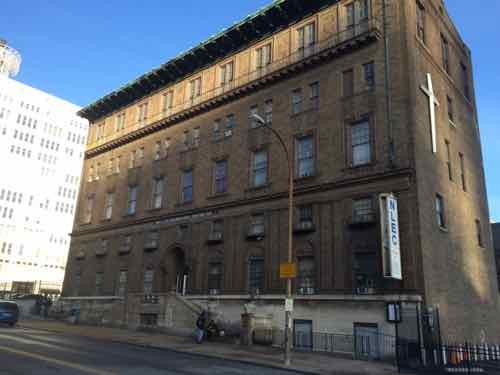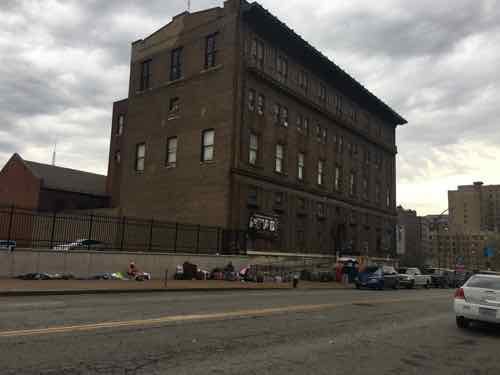KC Nonprofit Proposes Tiny House Village In North St. Louis To Assist Homeless Veterans
Homelessness is a problem coast to coast — in big cities and in small towns, in downtowns and in the suburbs. Often it’s invisible, other times it’s too visible. One of the groups who find themselves homeless are our veterans, men & women who served our country but then fell through the big holes in what’s left of our safety nets.
The U.S. Department of Veterans Affairs (VA) states that the nation’s homeless veterans are predominantly male, with roughly 9% being female. The majority are single; live in urban areas; and suffer from mental illness, alcohol and/or substance abuse, or co-occurring disorders. About 11% of the adult homeless population are veterans.
Roughly 45% of all homeless veterans are African American or Hispanic, despite only accounting for 10.4% and 3.4% of the U.S. veteran population, respectively.
Homeless veterans are younger on average than the total veteran population. Approximately 9% are between the ages of 18 and 30, and 41% are between the ages of 31 and 50. Conversely, only 5% of all veterans are between the ages of 18 and 30, and less than 23% are between 31 and 50.
America’s homeless veterans have served in World War II, the Korean War, Cold War, Vietnam War, Grenada, Panama, Lebanon, Persian Gulf War, Afghanistan and Iraq (OEF/OIF), and the military’s anti-drug cultivation efforts in South America. Nearly half of homeless veterans served during the Vietnam era. Two-thirds served our country for at least three years, and one-third were stationed in a war zone.
About 1.4 million other veterans, meanwhile, are considered at risk of homelessness due to poverty, lack of support networks, and dismal living conditions. (National Coalition for Homeless Veterans)
The above organization lists some stunning statistics:
DEMOGRAPHICS OF HOMELESS VETERANS
- 11% of the homeless adult population are veterans
- 20% of the male homeless population are veterans
- 68% reside in principal cities
- 32% reside in suburban/rural areas
- 51% of individual homeless veterans have disabilities
- 50% have serious mental illness
- 70% have substance abuse problems
- 57% are white males, compared to 38% of non-veterans
- 50% are age 51 or older, compared to 19% non-veterans
It should be clear that homeless veterans are a big group. Programs to assist the general population might help some, but a targeted approach will yield better results.
Veteran homelessness is related to another problem: veteran suicide.
Veterans with a history of homelessness are five times more likely to attempt suicide than other veterans, a new study by researchers at Yale and the U.S. Department of Veteran Affairs has found. (Yale)
The solution to homelessness appears to be getting them off the street and treatment for issues like substance abuse. Such treatment won’t work while on the street looking for their next meal or where to sleep. Housing becomes the key, but what kind?
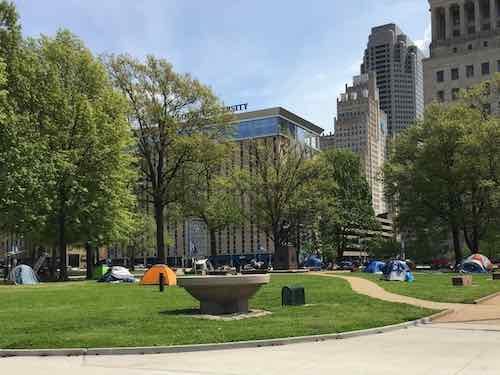
In the past SROs (single room occupancy) were an important housing option, but these have mostly disappeared. Tent cities are an option, but those lack privacy, showers, etc. Tent encampments are often run off from the land where they spring up. Five years ago a group opened Freedom House, a renovated apartment building, for homeless veterans. See Housing For Homeless Veterans Nearing Completion At 4011 Delmar.
A relatively new nonprofit, based in Kansas City, is trying a solution other cities have utilized: tiny houses. Veterans Community Project (VCP) now want to expand into St. Louis, focused on helping veterans with anything they need. Apparently accessing services available through the Veterans Administration (VA) isn’t easy, so they help veterans navigate the bureaucracy. They can also help veterans get other services outside those offered through the VA. And 50 tiny houses will give the men & women the security & stability they need to rebuild their lives.
At the land dedication event on friday a couple of speakers mentioned eradicating the problem of homeless veterans in Missouri. Sounds good, but homeless veterans exist outside of the Kansas City & St. Louis metro areas. While I’m skeptical about any claim to eradicate homelessness, this project will potentially make a significant dent in our total homeless population.
Let me walk you through their proposed project, then I’ll share a few areas of concern.
Located on a 5-acre property in the heart of the Jeff Vander Lou neighborhood, the Veterans Community Project campus includes a village of tiny houses for Veterans experiencing homelessness and a Veterans Outreach Center to provide walk-in support services for any Veteran in the St. Louis metro area.
VCP Village
VCP Village is a specialized community of 50 tiny homes with on-site, wraparound support services designed to equip Veterans with the tools needed to return to a stable, prosperous, independent life.
Each tiny house provides everything a Veteran needs to live with dignity and security; new furniture, appliances, housewares, bedding, personal items, and utilities – all free of charge. The homes offers sanctuary and the emotional space needed for each Veteran and VCP’s specially-trained team to thoroughly address the underlying causes of his or her homelessness.
With the support of their case managers and battle buddies, Veterans work to achieve incremental, lasting results in the areas of health and wellness, income stability, education and training, fiscal understanding, and the development of a personal support network. Once the Veteran’s individual goals are met, VCP assists him or her in securing a permanent housing solution and transitioning to a new life.The Veterans Outreach Center
Located on Grand Ave, the Veterans Outreach Center is a “one-stop” shop for any Veteran requiring support services such as emergency rent and utility assistance, food and hygiene kits, employment supports, military documentation and benefits navigation, and case management.
The project is modeled after VCP’s Kansas City model which has already served more than 4,100 at-risk Veterans and successfully transitioned more than 40 formerly homeless Veterans into permanent housing since its opening in 2018. (VCPSTL)
You can see an early construction aerial of their KC village here, so let’s take a look at their St. Louis proposal.
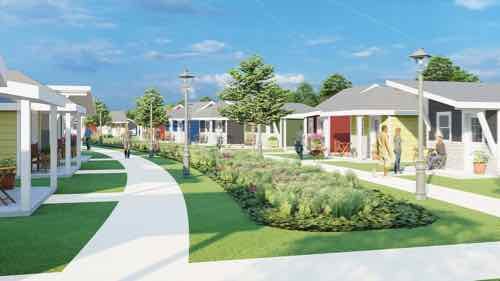
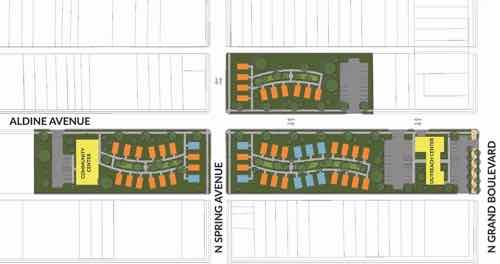
There’s a lot to like about their proposal:
- The services to veterans seems very important, even if not homeless. Too many serving the homeless offer just one part of what they need, sending them off to find the rest. This will hopefully result in a higher success rate.
- It’s close to the VA Hospital on Grand.
- The number of separate structures is roughly equal to what was here in 1909 (See Sanborn map).
- Tiny houses can be on wheels, modular, or built on site. This is the latter. These are permanent structures.
- Tiny houses are psychologically better than other transitional options because they immediately help the individual see themselves living in their own place, independent of others. It’s a baby step toward an apartment.
- Case managers will help keep these vets on track.
- There’s no rent, no limit how long they can stay.
- Ugly mostly vacant lots backed up to auto salvage businesses aren’t likely to be used for anything, especially new housing.
- No public streets vacated!
Obviously I’m a believer in tiny houses for transitional housing for the homeless, but I do have a problem with a couple of things and I have some suggestions.
Grand Boulevard is our longest north-south corridor, with the busiest bus route (#70). Pedestrians use the bus, and as part of an urban area all new construction along Grand should be urban in placement and massing. First, here’s how they plan to face Grand.
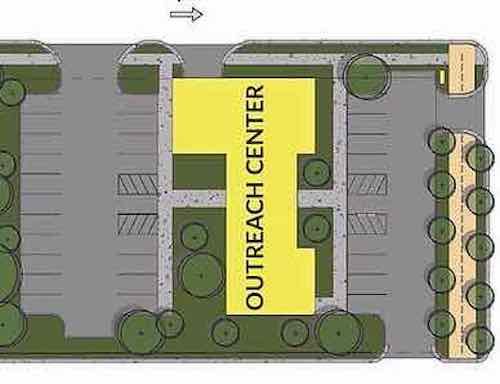
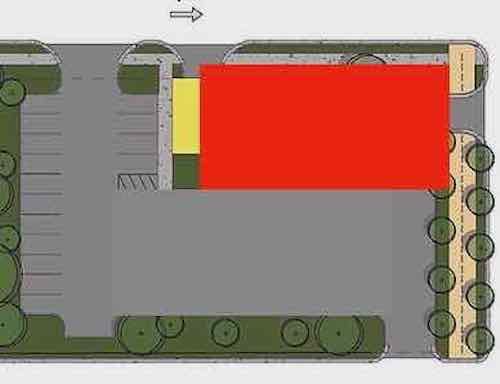
Rather than a curb cut leading to a garage door, this function should be off the parking lot — not interrupting the public sidewalk. The sidewalk along Grand should be as wide as possible, with tree wells, not tree lawns. This allows people who arrive by car to park in the parking lane and then step onto pavement, not grass. Same for the Aldine Ave side of the building.
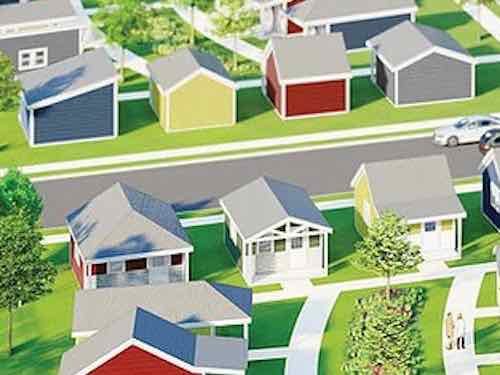
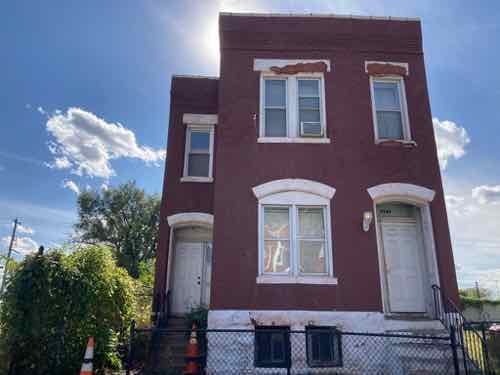
In addition to the above issues I have some suggestions to improve the project.
- Make the Aldine Ave 2-way as shown on the site plan.
- Corner curb bulbs to narrow streets, slow drivers. Also reduces the crossing distance, adds planter opportunities.
- Add some bioswales/rain gardens to Aldine Ave to catch water and reduce the amount of paving. With parking lanes Aldine Ave is too wide.
- Plan for internal walkways to alleys so residents can take their trash/recycling to the dumpsters.
The main thing I’d like to see is the outreach center building be up against the Grand sidewalk — not pushed back behind parking.
— Steve Patterson
